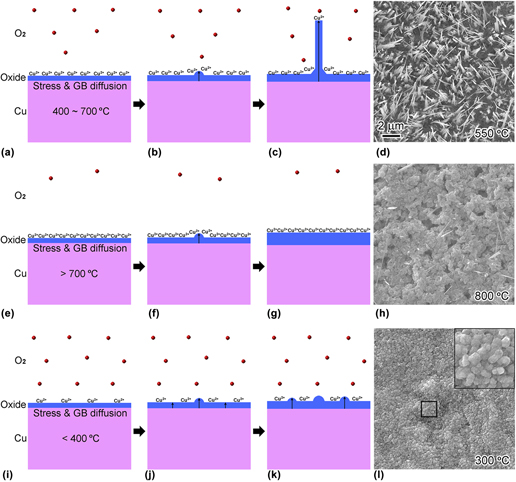Crossref Citations
This article has been cited by the following publications. This list is generated based on data provided by
Crossref.
Criado, Denise
and
Zúñiga, Alejandro
2019.
Influence of an electric current on the growth kinetics of CuO nanowires produced by oxidation.
Materials Today Communications,
Vol. 19,
Issue. ,
p.
18.
Kiani, Fatemeh
Sterl, Florian
Tsoulos, Ted V.
Weber, Ksenia
Giessen, Harald
and
Tagliabue, Giulia
2020.
Ultra-Broadband and Omnidirectional Perfect Absorber Based on Copper Nanowire/Carbon Nanotube Hierarchical Structure.
ACS Photonics,
Vol. 7,
Issue. 2,
p.
366.
Shi, Juan
Qiao, Liang
Zhao, Yi
Sun, Zhonggui
Feng, Wangjun
Zhang, Zhiya
Wang, Jun
and
Men, Xuehu
2020.
Synergistic effects on thermal growth of CuO nanowires.
Journal of Alloys and Compounds,
Vol. 815,
Issue. ,
p.
152355.
Huang, Chi-Hsin
Tang, Yalun
Matsuzaki, Kosuke
and
Nomura, Kenji
2020.
Resistive switching memory effects in p-type hydrogen-treated CuO nanowire.
Applied Physics Letters,
Vol. 117,
Issue. 4,
Ao, Yibo
Ao, Jinqing
Yang, Xiaoshan
Zhao, Ling
Hu, Liwei
Le, Guomin
Li, Jinfeng
Qu, Fengsheng
Zhou, Yuzhao
Wang, Xiaoying
Guo, Biao
and
Liu, Xue
2020.
Preparation and characterization of hierarchical nanostructures composed by CuO nanowires within directional microporous Cu.
Vacuum,
Vol. 182,
Issue. ,
p.
109774.
Siebert, Leonard
Wolff, Niklas
Ababii, Nicolai
Terasa, Maik-Ivo
Lupan, Oleg
Vahl, Alexander
Duppel, Viola
Qiu, Haoyi
Tienken, Maik
Mirabelli, Mattia
Sontea, Victor
Faupel, Franz
Kienle, Lorenz
and
Adelung, Rainer
2020.
Facile fabrication of semiconducting oxide nanostructures by direct ink writing of readily available metal microparticles and their application as low power acetone gas sensors.
Nano Energy,
Vol. 70,
Issue. ,
p.
104420.
Baranov, Oleg
Košiček, Martin
Filipič, Gregor
and
Cvelbar, Uroš
2021.
A deterministic approach to the thermal synthesis and growth of 1D metal oxide nanostructures.
Applied Surface Science,
Vol. 566,
Issue. ,
p.
150619.
Moise, Călin Constantin
Enache, Laura-Bianca
Anăstăsoaie, Veronica
Lazăr, Oana Andreea
Mihai, Geanina Valentina
Bercu, Mircea
and
Enăchescu, Marius
2021.
On the growth of copper oxide nanowires by thermal oxidation near the threshold temperature at atmospheric pressure.
Journal of Alloys and Compounds,
Vol. 886,
Issue. ,
p.
161130.
Siavash Moakhar, Roozbeh
Hosseini‐Hosseinabad, Seyed Morteza
Masudy‐Panah, Saeid
Seza, Ashkan
Jalali, Mahsa
Fallah‐Arani, Hesam
Dabir, Fatemeh
Gholipour, Somayeh
Abdi, Yaser
Bagheri‐Hariri, Mohiedin
Riahi‐Noori, Nastaran
Lim, Yee‐Fun
Hagfeldt, Anders
and
Saliba, Michael
2021.
Photoelectrochemical Water‐Splitting Using CuO‐Based Electrodes for Hydrogen Production: A Review.
Advanced Materials,
Vol. 33,
Issue. 33,
Shapouri, Samaneh
Rajabi Kalvani, Payam
Jahangiri, Ali Reza
and
Elahi, Seyed Mohammad
2021.
Physical characterization of copper oxide nanowire fabricated via magnetic-field assisted thermal oxidation.
Journal of Magnetism and Magnetic Materials,
Vol. 524,
Issue. ,
p.
167633.
Pawale, Rohan S.
Yadav, Suhasini J.
Salokhe, Balaji S.
More, Suraj M.
Patil, Sharad B.
Kim, Jin H.
and
Gurav, Kishor V.
2021.
Room Temperature Surface Oxidation by Alkalization of Binder Free CuO Nanostructured Electrode for Enhanced Supercapacitive Performance.
Macromolecular Symposia,
Vol. 400,
Issue. 1,
Deng, Daxiang
Zheng, Jian
Chen, Xiaolong
and
Sun, Wei
2021.
Fabrication and Characterization of CuO nanowires on V-shaped Microgroove surfaces.
Current Applied Physics,
Vol. 28,
Issue. ,
p.
26.
Hamdan, Ahmad
Agati, Marta
and
Boninelli, Simona
2021.
Selective Synthesis of 2D Mesoporous CuO Agglomerates by Pulsed Spark Discharge in Water.
Plasma Chemistry and Plasma Processing,
Vol. 41,
Issue. 1,
p.
433.
Zhang, Wei
and
Hou, Zhongyu
2022.
Preparation of CuO Nanoparticles Film on Cu Substrate by Air Cold Plasma and Its Photoelectrochemical Properties.
ACS Applied Energy Materials,
Vol. 5,
Issue. 11,
p.
14008.
Dai, Tiantian
Deng, Zanhong
Wang, Shimao
Fang, Xiaodong
and
Meng, Gang
2022.
Unveiling low-temperature thermal oxidation growth of W18O49 nanowires with metastable β-W films.
Nanoscale,
Vol. 14,
Issue. 13,
p.
5002.
Wojcieszak, Damian
Obstarczyk, Agata
Mańkowska, Ewa
Mazur, Michał
Kaczmarek, Danuta
Zakrzewska, Katarzyna
Mazur, Piotr
and
Domaradzki, Jarosław
2022.
Thermal oxidation impact on the optoelectronic and hydrogen sensing properties of p-type copper oxide thin films.
Materials Research Bulletin,
Vol. 147,
Issue. ,
p.
111646.
Košiček, Martin
Zavašnik, Janez
Baranov, Oleg
Šetina Batič, Barbara
and
Cvelbar, Uroš
2022.
Understanding the Growth of Copper Oxide Nanowires and Layers by Thermal Oxidation over a Broad Temperature Range at Atmospheric Pressure.
Crystal Growth & Design,
Vol. 22,
Issue. 11,
p.
6656.
Hussain, Iftikhar
Iqbal, Sarmad
Hussain, Tanveer
Cheung, Wai Lok
Khan, Shakeel Ahmad
Zhou, Jun
Ahmad, Muhammad
Khan, Shahid Ali
Lamiel, Charmaine
Imran, Muhammad
AlFantazi, Akram
and
Zhang, Kaili
2022.
Zn–Co-MOF on solution-free CuO nanowires for flexible hybrid energy storage devices.
Materials Today Physics,
Vol. 23,
Issue. ,
p.
100655.
Mihailova, Irena
Gerbreders, Vjaceslavs
Krasovska, Marina
Sledevskis, Eriks
Mizers, Valdis
Bulanovs, Andrejs
and
Ogurcovs, Andrejs
2022.
A non-enzymatic electrochemical hydrogen peroxide sensor based on copper oxide nanostructures.
Beilstein Journal of Nanotechnology,
Vol. 13,
Issue. ,
p.
424.
Murzin, Serguei P.
2022.
Formation of ZnO/CuO Heterostructures Based on Quasi-One-Dimensional Nanomaterials.
Applied Sciences,
Vol. 13,
Issue. 1,
p.
488.



